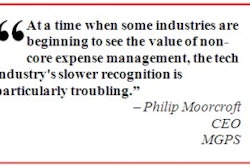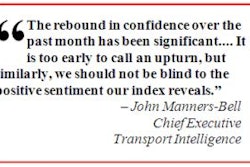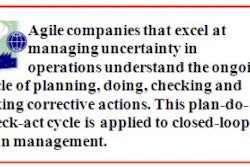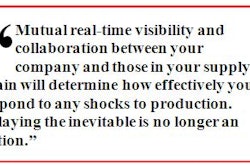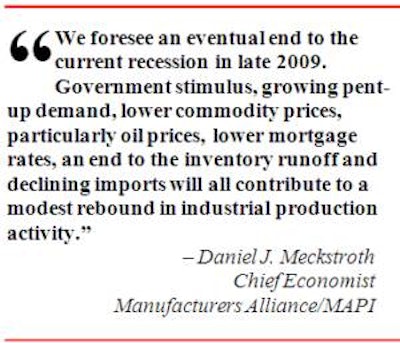
Arlington, VA — May 27, 2009 — U.S. manufacturing production continued to plummet in the first quarter of 2009 and the global contagion continues, but a confluence of factors portend a modest rebound in 2010, according to a new report from the Manufacturers Alliance/MAPI.
In its report, "U.S. Industrial Outlook: The 'Great' Recession," which analyzes 27 major industries, MAPI forecasts manufacturing production to fall 12 percent in 2009 and grow 2 percent in 2010 on an annual basis.
Manufacturing industrial production, measured on a quarter-to-quarter basis, declined at a 22 percent annual rate in first quarter 2009 after falling at an 18 percent annual rate in fourth quarter 2008.
"Unfortunately, there are no quick fixes," said Daniel J. Meckstroth, chief economist for the Manufacturers Alliance/MAPI and author of the analysis. "The deleveraging of the American consumer is ongoing and will continue for years. With heavy job loss, relatively low wage growth, tightened credit, falling housing prices and declining stock wealth, consumers are cutting spending for big-ticket and discretionary items in order to build up depleted saving reserves. Business spending for capital goods is also in full retreat."
However, Meckstroth offered a more optimistic view moving forward. "Fortunately, we foresee an eventual end to the current recession in late 2009," he said. "Government stimulus, growing pent-up demand, lower commodity prices, particularly oil prices, lower mortgage rates, an end to the inventory runoff and declining imports will all contribute to a modest rebound in industrial production activity."
Most Sectors See Orders Decline
Production in non-high-tech manufacturing dropped by a precipitous 22 percent annual rate in the first quarter of 2009. Non-high-tech manufacturing production is expected to mirror the overall production numbers, declining 12 percent this year before increasing 2 percent in 2010. High-tech industrial production also fell at a 22 percent annual rate in the first quarter of 2009. MAPI predicts it will decline 11 percent in 2009 and post 9 percent growth in 2010.
There was a broad downturn in the 2009 first quarter figures for the various components of the manufacturing economy. Only two of the 27 industries tracked in the report had inflation-adjusted new orders or production above the level of one year ago, five fewer than reported in fourth quarter 2008. One industry was flat, and 24 industries had production below the level of one year ago.
The largest drop came in steel production, which declined 61 percent. Material handling equipment fell by 56 percent, housing starts retrenched by 50 percent, motor vehicles and parts dropped by 41 percent, and semiconductors declined by 40 percent.
Turnaround Anticipated
Meckstroth finds that no industries are in the accelerating growth (recovery) phase of the business cycle; two are in the decelerating growth (expansion) phase; 24 industries appear to be in the accelerating decline (either early recession or mid-recession) phase; and one, aerospace products and parts, is in the decelerating decline (late recession or very mild recession) phase of the cycle.
The report also offers economic forecasts for 24 of the 27 industries for 2009 and 2010. The recession in the manufacturing sector is expected to last much of this year, with MAPI forecasting only three of 24 industries to show gains: aerospace products and parts is predicted to grow by 5 percent, and communications equipment and medical equipment and supplies are each forecast to grow by 1 percent in 2009.
A turnaround is anticipated to begin in 2010, with 17 of 24 industries expected to expand, led by housing starts at a healthy 81 percent increase from this year's depressed levels. Motor vehicles and parts production is finally anticipated to ramp up, growing by 15 percent, in 2010 after an expected decline of 32 percent this year.
Five industries are expected to experience negative change in both 2009 and in 2010, with mining and oil and gas field machinery showing the most weakness. That industry is expected to decline by 20 percent in 2009 and by 14 percent in 2010.
In its report, "U.S. Industrial Outlook: The 'Great' Recession," which analyzes 27 major industries, MAPI forecasts manufacturing production to fall 12 percent in 2009 and grow 2 percent in 2010 on an annual basis.
Manufacturing industrial production, measured on a quarter-to-quarter basis, declined at a 22 percent annual rate in first quarter 2009 after falling at an 18 percent annual rate in fourth quarter 2008.
"Unfortunately, there are no quick fixes," said Daniel J. Meckstroth, chief economist for the Manufacturers Alliance/MAPI and author of the analysis. "The deleveraging of the American consumer is ongoing and will continue for years. With heavy job loss, relatively low wage growth, tightened credit, falling housing prices and declining stock wealth, consumers are cutting spending for big-ticket and discretionary items in order to build up depleted saving reserves. Business spending for capital goods is also in full retreat."
However, Meckstroth offered a more optimistic view moving forward. "Fortunately, we foresee an eventual end to the current recession in late 2009," he said. "Government stimulus, growing pent-up demand, lower commodity prices, particularly oil prices, lower mortgage rates, an end to the inventory runoff and declining imports will all contribute to a modest rebound in industrial production activity."
Most Sectors See Orders Decline
Production in non-high-tech manufacturing dropped by a precipitous 22 percent annual rate in the first quarter of 2009. Non-high-tech manufacturing production is expected to mirror the overall production numbers, declining 12 percent this year before increasing 2 percent in 2010. High-tech industrial production also fell at a 22 percent annual rate in the first quarter of 2009. MAPI predicts it will decline 11 percent in 2009 and post 9 percent growth in 2010.
There was a broad downturn in the 2009 first quarter figures for the various components of the manufacturing economy. Only two of the 27 industries tracked in the report had inflation-adjusted new orders or production above the level of one year ago, five fewer than reported in fourth quarter 2008. One industry was flat, and 24 industries had production below the level of one year ago.
The largest drop came in steel production, which declined 61 percent. Material handling equipment fell by 56 percent, housing starts retrenched by 50 percent, motor vehicles and parts dropped by 41 percent, and semiconductors declined by 40 percent.
Turnaround Anticipated
Meckstroth finds that no industries are in the accelerating growth (recovery) phase of the business cycle; two are in the decelerating growth (expansion) phase; 24 industries appear to be in the accelerating decline (either early recession or mid-recession) phase; and one, aerospace products and parts, is in the decelerating decline (late recession or very mild recession) phase of the cycle.
The report also offers economic forecasts for 24 of the 27 industries for 2009 and 2010. The recession in the manufacturing sector is expected to last much of this year, with MAPI forecasting only three of 24 industries to show gains: aerospace products and parts is predicted to grow by 5 percent, and communications equipment and medical equipment and supplies are each forecast to grow by 1 percent in 2009.
A turnaround is anticipated to begin in 2010, with 17 of 24 industries expected to expand, led by housing starts at a healthy 81 percent increase from this year's depressed levels. Motor vehicles and parts production is finally anticipated to ramp up, growing by 15 percent, in 2010 after an expected decline of 32 percent this year.
Five industries are expected to experience negative change in both 2009 and in 2010, with mining and oil and gas field machinery showing the most weakness. That industry is expected to decline by 20 percent in 2009 and by 14 percent in 2010.




